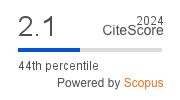Blockchain Based Cryptographic Algorithm for Data Protection in Electronic Voting System
DOI:
https://doi.org/10.4108/eetiot.7680Keywords:
Electronic Voting System, Cryptography, Data Protection, Encryption, Decryption, BlockchainAbstract
The development of digital world created advancement of technology, by which the data services are electronically transacted. Electronic voting is used to improve the election system in several ways. But technical issues associated with protection of data, is considered as a major concern leading to illegal activities and threats. Some of the conventional methods used in securing e-votes are matching finger prints of individual, control unit accessibility, which provides decreased capability of attaining proper authenticity and security. Even several cryptographic methods are used for data security, but produced limited accuracy. So, to improve the reliability and accuracy of data protection in e-voting, combination of AES (Advanced Encryption System) and RSA (Rivest, Shamir, Adleman) combined with blockchain technology is implemented. AES uses larger key size which makes the data privacy robust. But encryption and decryption time produces decreases computational speed. So, AES is combined with RSA, as it uses shorter key length and easy to implement with block-chain algorithm, it is deployed to decrease encryption and decryption time, thus producing highly sensitive data security. The performance of the system is validated by calculating the encryption and decryption time, block size and verification time of original data with output data.
Downloads
References
[1] A. Solankar, "Secure E-Voting System Using Visual Cryptography & Block Chain Ledger," Turkish Journal of Computer and Mathematics Education (TURCOMAT), vol. 12, no. 1S, pp. 7-12, 2021.
[2] A. Alotaibi, L. Alhubaidi, A. Alyami, L. Marghalani, B. Alharbi, and N. Nagy, "Preventing Phishing Attack on Voting System Using Visual Cryptography," Journal of Computer and Communications, vol. 10, no. 10, pp. 149-161, 2022.
[3] S. Priya, G. Srivastava, and S. Kumar, "Secured Electronic Voting Transactions Integrated with Blockchain," 2021.
[4] S. Tanwar, N. Gupta, P. Kumar, and Y.-C. Hu, "Implementation of blockchain-based e-voting system," Multimedia Tools and Applications, vol. 83, no. 1, pp. 1449-1480, 2024.
[5] C. Toma, M. Popa, C. Boja, C. Ciurea, and M. Doinea, "Secure and Anonymous Voting D-App with IoT Embedded Device Using Blockchain Technology," Electronics, vol. 11, no. 12, p. 1895, 2022.
[6] B. Ali, F. Iqbal, I. Hussain, and M. Younas, "An Efficient E-Voting Algorithm and Dapp Using Blockchain Technology," Multidisciplinary International Journal of Research and Development (MIJRD), vol. 1, no. 03, pp. 60-69, 2022.
[7] K. N. Rahman, M. W. Hridoy, M. M. Rahman, M. R. Islam, and S. Banik, "Highly secured and effective management of app-based online voting system using RSA encryption and decryption," Heliyon, vol. 10, no. 3, 2024.
[8] E. Daraghmi, A. Hamoudi, and M. Abu Helou, "Decentralizing Democracy: Secure and Transparent E-Voting Systems with Blockchain Technology in the Context of Palestine," Future Internet, vol. 16, no. 11, p. 388, 2024.
[9] S. Gupta, K. K. Gupta, and P. K. Shukla, "Improving the End‐to‐End Protection in E‐Voting Using BVM—Blockchain‐Based E‐Voting Mechanism," Concurrency and Computation: Practice and Experience, p. e8324, 2024.
[10] R. K. Muhammed, K. H. A. Faraj, J. F. Gul-Mohammed, T. N. A. Al Attar, S. J. Saydah, and D. A. Rashid, "Automated Performance analysis E-services by AES-Based Hybrid Cryptosystems with RSA, ElGamal, and ECC," Advances in Science, Technology and Engineering Systems Journal, vol. 9, no. 3, pp. 84-91, 2024.
[11] K.-L. Tsai, F.-Y. Leu, I. You, S.-W. Chang, S.-J. Hu, and H. Park, "Low-power AES data encryption architecture for a LoRaWAN," IEEE Access, vol. 7, pp. 146348-146357, 2019.
[12] S. Ajish and K. AnilKumar, "Secure mobile internet voting system using biometric authentication and wavelet based AES," Journal of Information Security and Applications, vol. 61, p. 102908, 2021.
[13] B. A. Oke, O. M. Olaniyi, A. Aboaba, and O. T. Arulogun, "Securing electronic voting system using crystographic technique," 2019.
[14] O. S. Adewale, O. K. Boyinbode, and E. A. Salako, "Visual semagram: An enhanced technique for confidentiality requirement of electronic voting system," International Journal of Computer Network and Information Security, vol. 12, no. 4, pp. 51-59, 2020.
[15] S. Latif and T. Anees, "Blockchain based Decentralized Electronic Voting System: A Step towards Transparent Elections," IJCSNS, vol. 19, no. 12, p. 165, 2019.
[16] K. G. Houlder, P. Nithishwar, G. Santhosh, and E. Venkatesh, "A Secure Verifiable Internet Voting System Using Identity Based Encryption And Decryption."
[17] S. Jayanti, K. Chittibabu, P. Chaganti, And C. Sekhar, "A Novel Cryptosystem Of An Upgraded Classical Cipher And Rsa Algorithm For A Secure And An Efficient Electronic Voting System," Journal of Theoretical and Applied Information Technology, vol. 101, no. 4, 2023.
[18] J. Bhatti, S. Chachra, A. Walia, and A. Vishal, "Secure electronic voting machine using multi-modal biometric authentication system, data encryption, and firewall," International Journal of Performability Engineering, vol. 15, no. 10, p. 2570, 2019.
[19] R. Taş and Ö. Ö. Tanrıöver, "A manipulation prevention model for blockchain-based e-voting systems," Security and communication networks, vol. 2021, pp. 1-16, 2021.
[20] J. Lyu, Z. L. Jiang, X. Wang, Z. Nong, M. H. Au, and J. Fang, "A secure decentralized trustless E-voting system based on smart contract," in 2019 18th IEEE International Conference On Trust, Security And Privacy In Computing And Communications/13th IEEE International Conference On Big Data Science And Engineering (TrustCom/BigDataSE), 2019: IEEE, pp. 570-577.
Downloads
Published
Issue
Section
License
Copyright (c) 2025 Vinayachandra, Krishna Prasad K

This work is licensed under a Creative Commons Attribution-NonCommercial-ShareAlike 4.0 International License.
This is an open-access article distributed under the terms of the Creative Commons Attribution CC BY 4.0 license, which permits unlimited use, distribution, and reproduction in any medium so long as the original work is properly cited.




